AURALiC has made something of a name for themselves in a short time, with the introduction of a string of well made products at relatively moderate price points- among them the AURALiC Taurus Headphone Amplifier, the Vega DAC, and the AURALiC MERAK Class D mono block amplifiers. The Taurus Pre is a basic preamp similar to the Taurus, but optimized for conventional preamp duties rather than as a head phone device; however, it sill has the dual headphone outputs and a mode switch to change between BPA (Balanced Phone Amplifier) and Pre. With three unbalanced sets of inputs and one balanced set, and balanced and unbalanced outputs, it tends a bit towards the miminalist configuration, but uses AURALiC's OREFEO Class A modules for amplification which are based on classic NEVE analog mixing console, and assays to bring the best characteristics of those beloved monsters to your home audio system.
 1 by Jon Hancock, on Flickr
1 by Jon Hancock, on Flickr
I've only had a limited opportunity to listen to it, and all through headphones, so at some future date when my main system is stable instead of being used for experimentation so much, I'll report back on what I think of it in that mode. With my newer highly rated Audio Technica ATH-MSR7GM, I have no complaints at all.
The most basic spec is frequency response, and for this I could just measure to 20kHz, but I usually look up a bit higher, to see where the roll off is. Oddly, that's not what we see with the Taurus Pre; I checked both the volume control max'd and at about -8 dB, and as you can see, above 20 kHz there is a gently rising response, reaching about +2 dB at 200 kHz; above there it flattens out. I've seen this kind of increase in gain used to gain a higher closed loop bandwidth by increasing the gain at a higher frequency so that the loop closure happens at a lower frequency than it would at the lower gain. (that doesn't make much sense without a Bode plot, but just take it on faith for the moment).
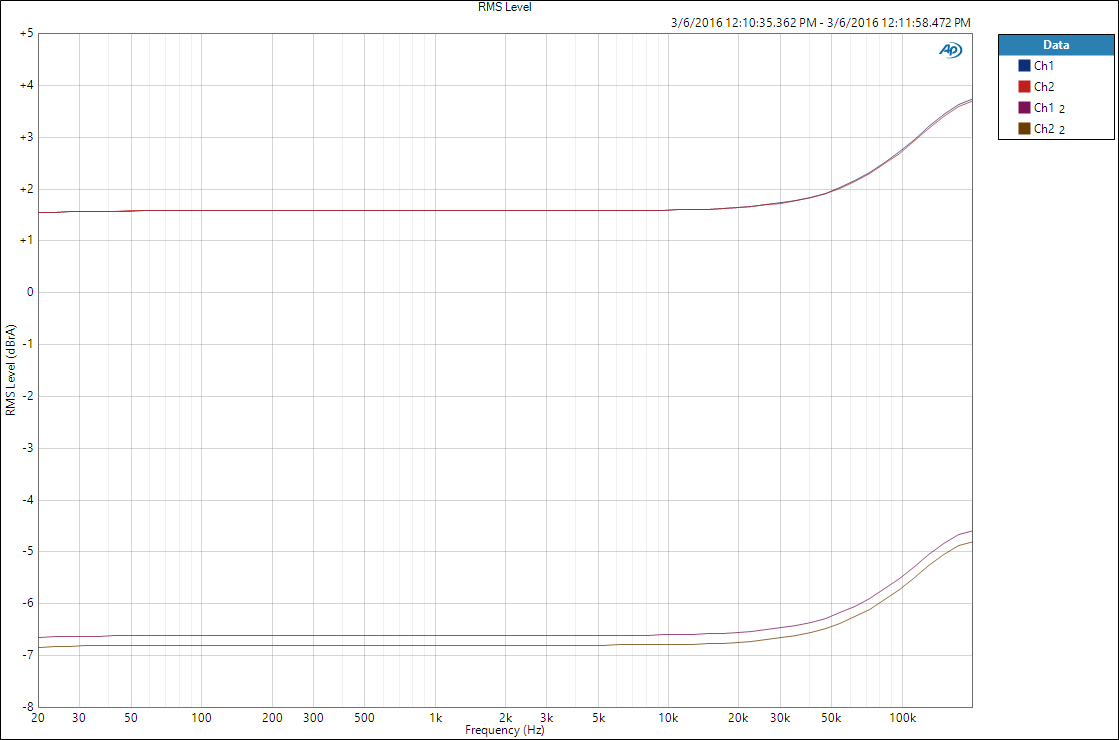 RMS Level FreqSweep_-8dB_Added by Jon Hancock, on Flickr
RMS Level FreqSweep_-8dB_Added by Jon Hancock, on Flickr
Note the spread in the left and right gain at the lower setting? This is how using a conventional variable pot volume control introduces slight gain mismatches, due to errors in resistive tracking. Some preamps use elaborate switched resistors or transformer taps or even special multiplying DACs as precision resistor networks, but that's not found in the Taurus Pre.
Next up we're looking at an FFT of the output (both channels) in the range from DC to 1K, linear scale, while driving about 1VRMS into the output. This is just away to look at lower frequency residual noise, and we can see some supply related noise at line frequency increments at 60Hz, 180Hz, 240Hz, 300Hz, etc, but it's all at very low levels, below -110dB. Is it possible to do better than this? Yes. Their own DAC, the Vega, shows that is the case. Will it be audible in your system? Not very likely, unless you have some monster horns and a big amp.
 FFT Spectrum 1kHz by Jon Hancock, on Flickr
FFT Spectrum 1kHz by Jon Hancock, on Flickr
Next up, lets look at the trend of THD+N, measured at 1 kHz, against the output voltage RMS level.
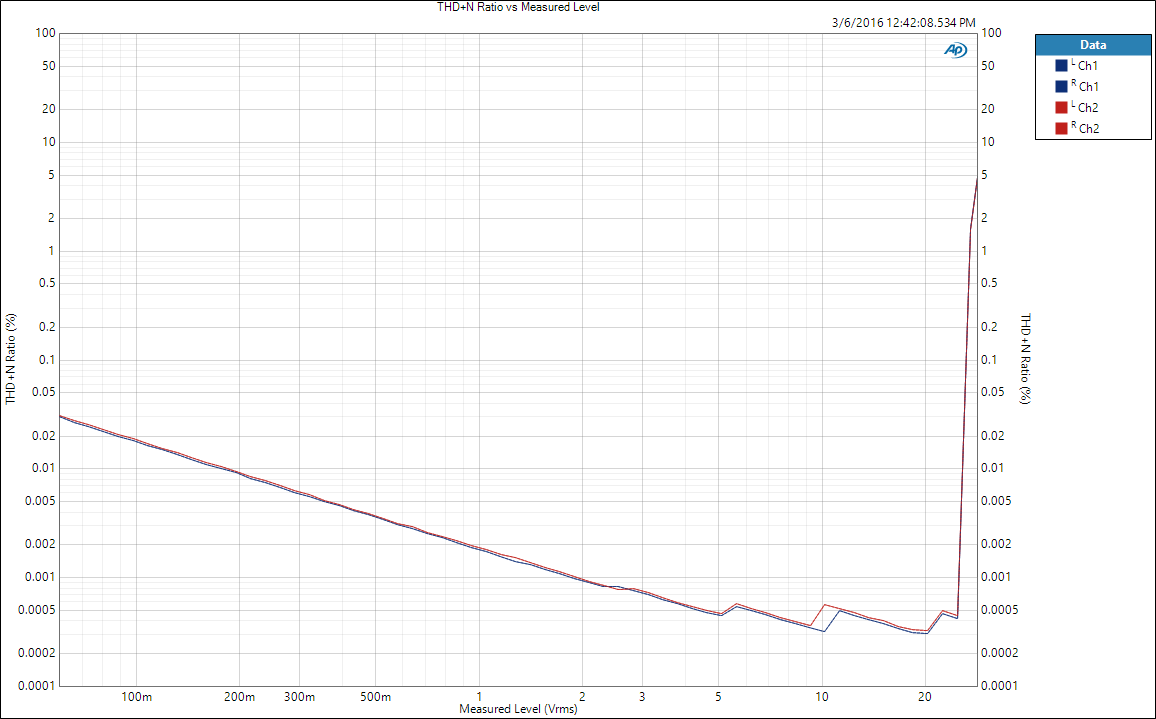 THD+N Ratio vs Measured Level by Jon Hancock, on Flickr
THD+N Ratio vs Measured Level by Jon Hancock, on Flickr
Now, here is where things get interesting and we get the measure of AURALiC's design efforts, as this result is very, very good- in fact, it compares quite well with the Boulder Audio 2110 Line Preamp, as measured by Stereophile, and actually edges the Boulder out slightly in THD+N at low levels, such as 100mV RMS output, and hangs in there quite well at the upper range, to beyond 20VRMS output, though it can't match the nearly 30VRMS output capability of the Boulder 2110. OTOH, it goes for less than $3K, not $54K. The Boulder 2110, measured last year by John Atkinson, is the best measuring preamp he has tested for Stereophile. To date, he has not tested the Taurus Pre.
How about THD+N ratio versus frequency? Here, the result is plotted for a fairly typical 1.5VRMS out- it will be lower at higher output levels, up to 10VRMS, but only with specialty amps like the Benchmark AHB2 might you be using it with that output level.
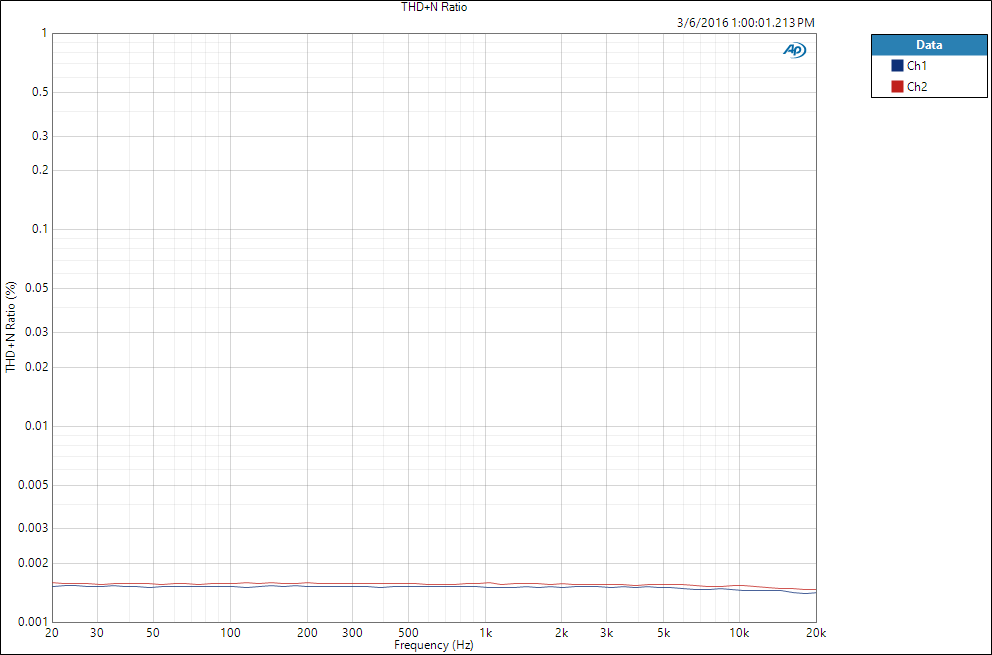 THD+N RatioFrequencySweep by Jon Hancock, on Flickr
THD+N RatioFrequencySweep by Jon Hancock, on Flickr
This is a very nice result, no increase at all in THD from the low frequency range to the highest normal audible frequency; this should result in a very clean and consistent presentation.
Next thing I'm going to throw on the screen today is a bit of a torture test, 50Hz at +20dB, about 10VRMS;
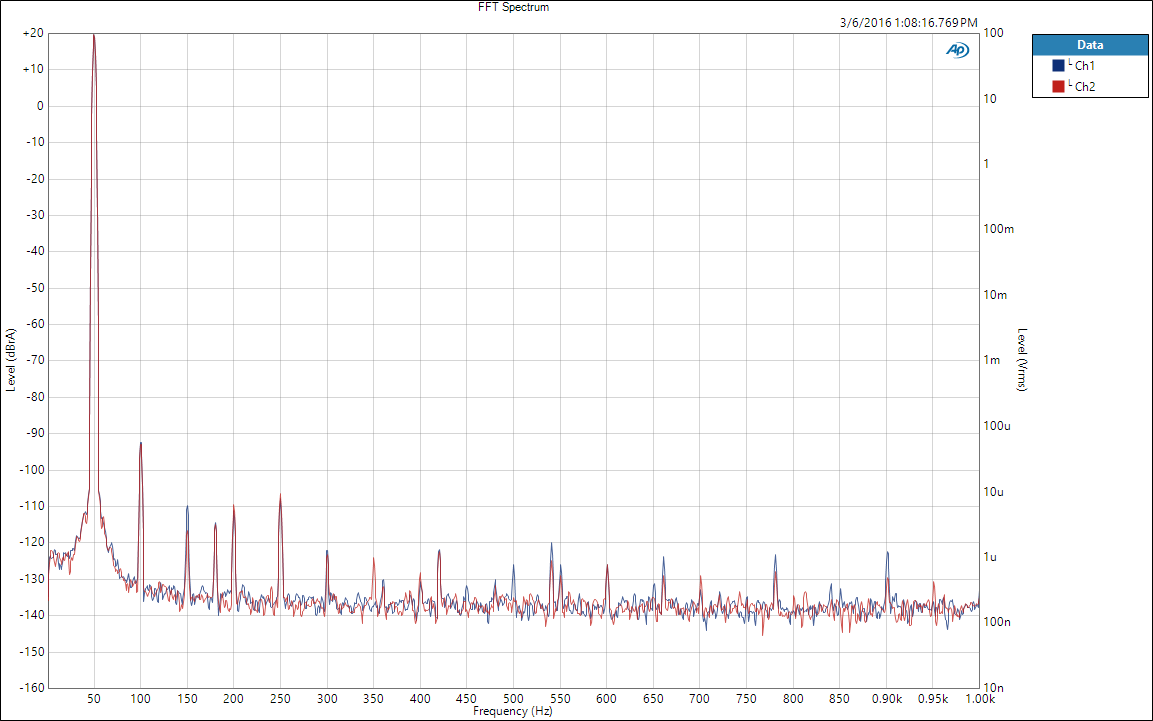 FFT Spectrum50Hz_10VRMS by Jon Hancock, on Flickr
FFT Spectrum50Hz_10VRMS by Jon Hancock, on Flickr
We do see some 2nd harmonic at about -92 dB, other components are at -110dB or even lower. Linear scale from 1 Hz to 1kHz. Now, considering how low those components are, how much is the Preamp, how much is the APx555 analyzer I'm using?
Here's a fold back test result of the same test, with the test signal just fed back to the analyzer without going through the preamp.
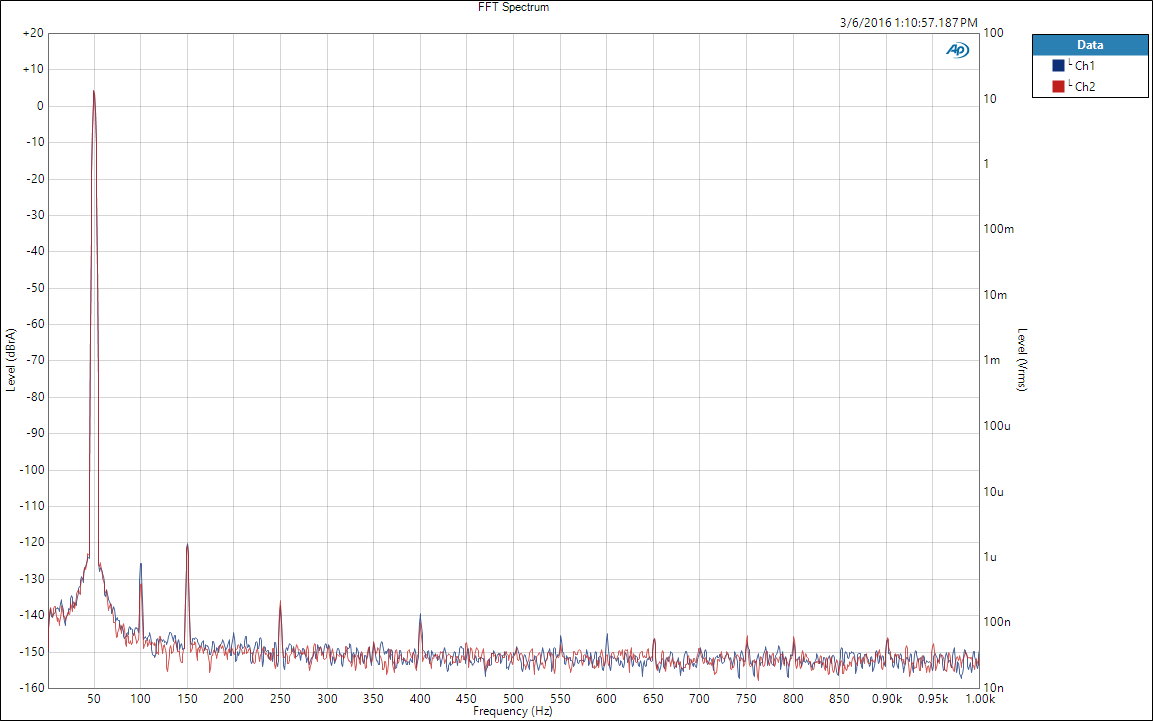 FFT Spectrum50Hz_LoopBack by Jon Hancock, on Flickr
FFT Spectrum50Hz_LoopBack by Jon Hancock, on Flickr
Keeping in mind we've got about 14 dB of gain, you can see which components are intrinsic to the Analyzer (generator and receiver) versus what is being generated by the preamp.
Last up is a test we see more often for power amps and DACs; they tend to have more trouble with this, but my experience has been that line preamps often choke a bit on this also- CCIF HF intermodulation, such as 19kHz + 20kHz mixed at equal levels. In this case, we're testing at 1.6VRMS for each frequency; this is a signal that if you feed it to your system, you could kiss your tweeters good bye right away... but it's also a good alternative to square wave DIM testing, and can show up problems with side band clusters appearing above and below the nominal test frequencies.
First, a look within the normal audio bandwidth- a linear plot (to make frequency identification easier)
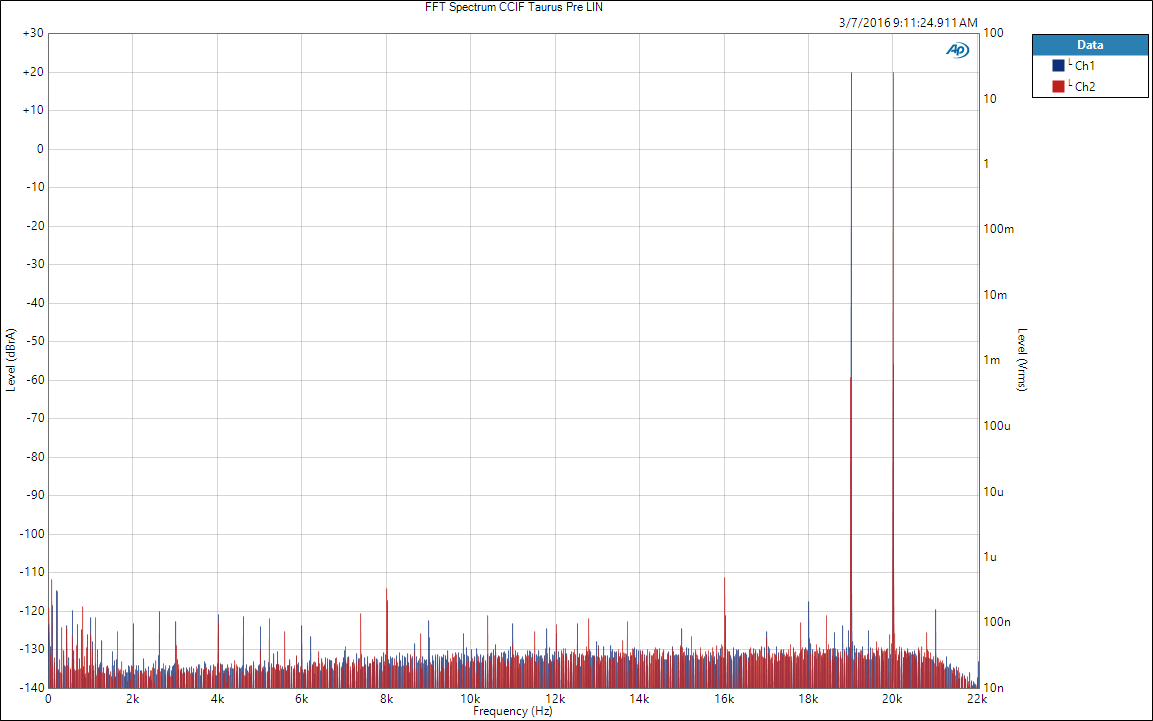 FFT Spectrum CCIF Taurus Pre LIN by Jon Hancock, on Flickr
FFT Spectrum CCIF Taurus Pre LIN by Jon Hancock, on Flickr
Note that there are negligible sidebands around the actual test frequencies, and the "obvious" 1kHz difference frequency, if present, is down in the mud below -120 dB, which makes it -140db relative to the individual signal components!
Here's the wideband linear plot - now we see some harmonic components, but it's mostly just 2nd and 3rd harmonic distortion at -94 and lower relative to the output level, and sideband components at a very low level.
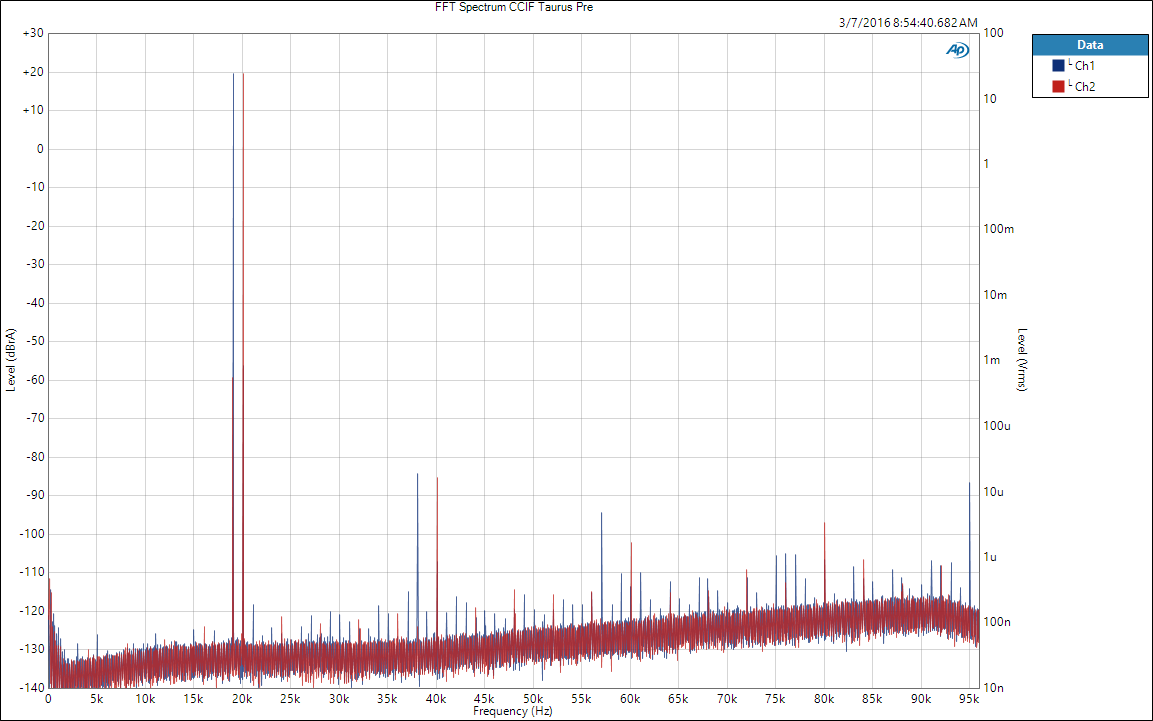 FFT Spectrum CCIF Taurus PreCCIF_LIN by Jon Hancock, on Flickr
FFT Spectrum CCIF Taurus PreCCIF_LIN by Jon Hancock, on Flickr
The actual DUT under test, SN# 4214...
 IMG_0507 2 by Jon Hancock, on Flickr
IMG_0507 2 by Jon Hancock, on Flickr
and the test setup, APx555 with a Dell XPS 15" as the controller computer.
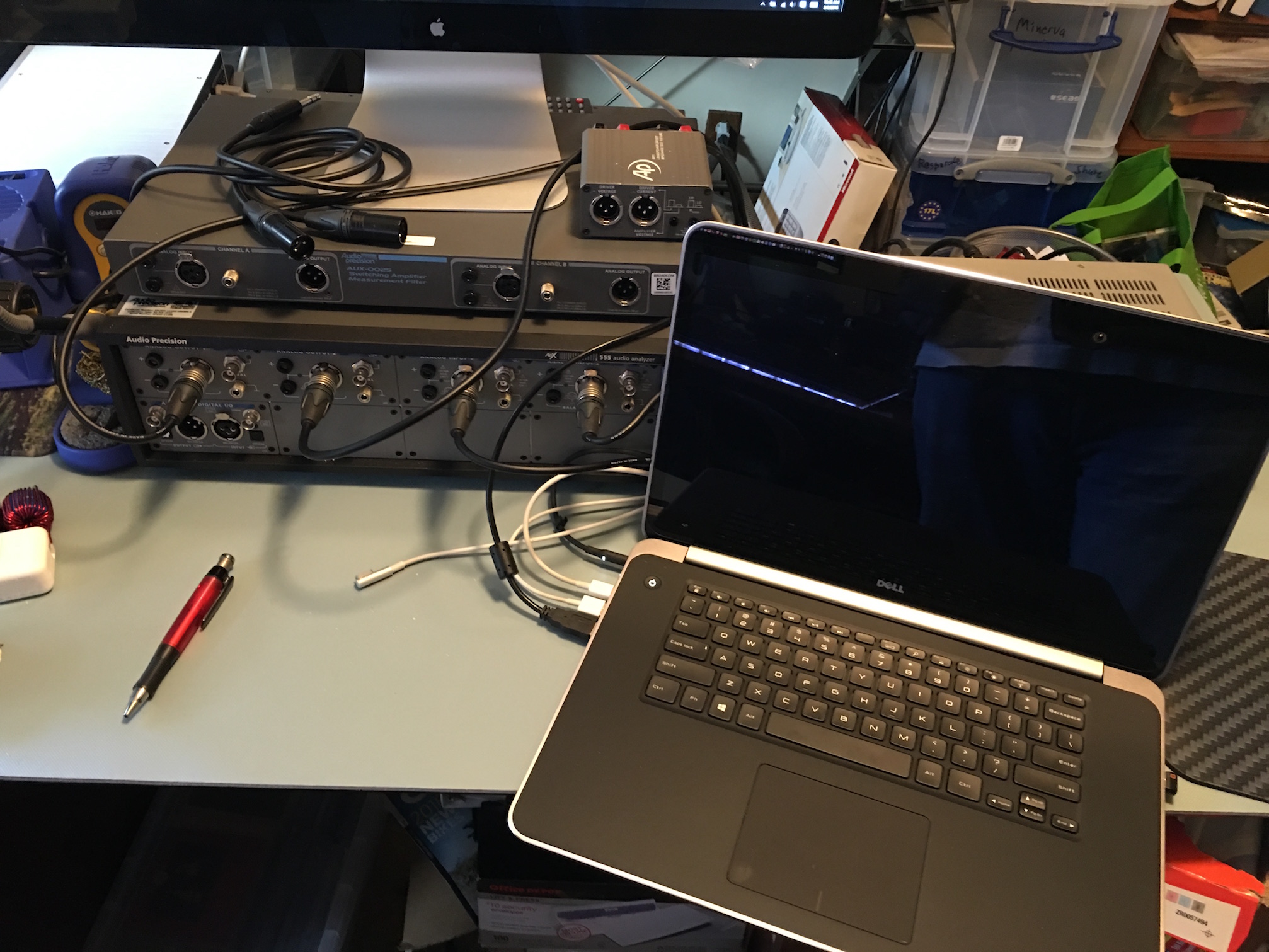 IMG_9316 2 by Jon Hancock, on Flickr
IMG_9316 2 by Jon Hancock, on Flickr
All in all, though the out of band frequency response could be flatter, and the channel tracking at lower volume is OK, but not great, in many other aspects this is a very high performing unit, considering what it costs. if you're in the market for a compact preamp without too many inputs needed, this could be up your alley. AURALiC seems to have done a very good job of capturing some of the best performance aspects of the Neve gain modules, and the measured performance displays excellent performance for this and most other price points.
Positives:
Concerns:
Other units to check out in this range might include the Cambridge 851e, which I'll also be testing in the near future, after my upcoming two weeks of business travel.
If any of you have given the Taurus Pre a listen, feel free to chime in with your comments.
 1 by Jon Hancock, on Flickr
1 by Jon Hancock, on FlickrI've only had a limited opportunity to listen to it, and all through headphones, so at some future date when my main system is stable instead of being used for experimentation so much, I'll report back on what I think of it in that mode. With my newer highly rated Audio Technica ATH-MSR7GM, I have no complaints at all.
The most basic spec is frequency response, and for this I could just measure to 20kHz, but I usually look up a bit higher, to see where the roll off is. Oddly, that's not what we see with the Taurus Pre; I checked both the volume control max'd and at about -8 dB, and as you can see, above 20 kHz there is a gently rising response, reaching about +2 dB at 200 kHz; above there it flattens out. I've seen this kind of increase in gain used to gain a higher closed loop bandwidth by increasing the gain at a higher frequency so that the loop closure happens at a lower frequency than it would at the lower gain. (that doesn't make much sense without a Bode plot, but just take it on faith for the moment).
 RMS Level FreqSweep_-8dB_Added by Jon Hancock, on Flickr
RMS Level FreqSweep_-8dB_Added by Jon Hancock, on FlickrNote the spread in the left and right gain at the lower setting? This is how using a conventional variable pot volume control introduces slight gain mismatches, due to errors in resistive tracking. Some preamps use elaborate switched resistors or transformer taps or even special multiplying DACs as precision resistor networks, but that's not found in the Taurus Pre.
Next up we're looking at an FFT of the output (both channels) in the range from DC to 1K, linear scale, while driving about 1VRMS into the output. This is just away to look at lower frequency residual noise, and we can see some supply related noise at line frequency increments at 60Hz, 180Hz, 240Hz, 300Hz, etc, but it's all at very low levels, below -110dB. Is it possible to do better than this? Yes. Their own DAC, the Vega, shows that is the case. Will it be audible in your system? Not very likely, unless you have some monster horns and a big amp.
 FFT Spectrum 1kHz by Jon Hancock, on Flickr
FFT Spectrum 1kHz by Jon Hancock, on FlickrNext up, lets look at the trend of THD+N, measured at 1 kHz, against the output voltage RMS level.
 THD+N Ratio vs Measured Level by Jon Hancock, on Flickr
THD+N Ratio vs Measured Level by Jon Hancock, on FlickrNow, here is where things get interesting and we get the measure of AURALiC's design efforts, as this result is very, very good- in fact, it compares quite well with the Boulder Audio 2110 Line Preamp, as measured by Stereophile, and actually edges the Boulder out slightly in THD+N at low levels, such as 100mV RMS output, and hangs in there quite well at the upper range, to beyond 20VRMS output, though it can't match the nearly 30VRMS output capability of the Boulder 2110. OTOH, it goes for less than $3K, not $54K. The Boulder 2110, measured last year by John Atkinson, is the best measuring preamp he has tested for Stereophile. To date, he has not tested the Taurus Pre.
How about THD+N ratio versus frequency? Here, the result is plotted for a fairly typical 1.5VRMS out- it will be lower at higher output levels, up to 10VRMS, but only with specialty amps like the Benchmark AHB2 might you be using it with that output level.
 THD+N RatioFrequencySweep by Jon Hancock, on Flickr
THD+N RatioFrequencySweep by Jon Hancock, on FlickrThis is a very nice result, no increase at all in THD from the low frequency range to the highest normal audible frequency; this should result in a very clean and consistent presentation.
Next thing I'm going to throw on the screen today is a bit of a torture test, 50Hz at +20dB, about 10VRMS;
 FFT Spectrum50Hz_10VRMS by Jon Hancock, on Flickr
FFT Spectrum50Hz_10VRMS by Jon Hancock, on FlickrWe do see some 2nd harmonic at about -92 dB, other components are at -110dB or even lower. Linear scale from 1 Hz to 1kHz. Now, considering how low those components are, how much is the Preamp, how much is the APx555 analyzer I'm using?
Here's a fold back test result of the same test, with the test signal just fed back to the analyzer without going through the preamp.
 FFT Spectrum50Hz_LoopBack by Jon Hancock, on Flickr
FFT Spectrum50Hz_LoopBack by Jon Hancock, on FlickrKeeping in mind we've got about 14 dB of gain, you can see which components are intrinsic to the Analyzer (generator and receiver) versus what is being generated by the preamp.
Last up is a test we see more often for power amps and DACs; they tend to have more trouble with this, but my experience has been that line preamps often choke a bit on this also- CCIF HF intermodulation, such as 19kHz + 20kHz mixed at equal levels. In this case, we're testing at 1.6VRMS for each frequency; this is a signal that if you feed it to your system, you could kiss your tweeters good bye right away... but it's also a good alternative to square wave DIM testing, and can show up problems with side band clusters appearing above and below the nominal test frequencies.
First, a look within the normal audio bandwidth- a linear plot (to make frequency identification easier)
 FFT Spectrum CCIF Taurus Pre LIN by Jon Hancock, on Flickr
FFT Spectrum CCIF Taurus Pre LIN by Jon Hancock, on FlickrNote that there are negligible sidebands around the actual test frequencies, and the "obvious" 1kHz difference frequency, if present, is down in the mud below -120 dB, which makes it -140db relative to the individual signal components!
Here's the wideband linear plot - now we see some harmonic components, but it's mostly just 2nd and 3rd harmonic distortion at -94 and lower relative to the output level, and sideband components at a very low level.
 FFT Spectrum CCIF Taurus PreCCIF_LIN by Jon Hancock, on Flickr
FFT Spectrum CCIF Taurus PreCCIF_LIN by Jon Hancock, on FlickrThe actual DUT under test, SN# 4214...
 IMG_0507 2 by Jon Hancock, on Flickr
IMG_0507 2 by Jon Hancock, on Flickrand the test setup, APx555 with a Dell XPS 15" as the controller computer.
 IMG_9316 2 by Jon Hancock, on Flickr
IMG_9316 2 by Jon Hancock, on FlickrAll in all, though the out of band frequency response could be flatter, and the channel tracking at lower volume is OK, but not great, in many other aspects this is a very high performing unit, considering what it costs. if you're in the market for a compact preamp without too many inputs needed, this could be up your alley. AURALiC seems to have done a very good job of capturing some of the best performance aspects of the Neve gain modules, and the measured performance displays excellent performance for this and most other price points.
Positives:
- Very low noise, very low distortion by all test measures
- High voltage output capability due to custom output modules- can drive Pro Audio levels
- Includes a balanced ouptut, one balanced input
- Compact size, high build quality
- Optimizaitons for high quality headphone drive also
- Moderate/low cost relative to performance
Concerns:
- Limited number of inputs (4 total), only one set of balanced inputs
- Simple resistive pot volume control shows typical minor tracking issues at reduced gain
- No HT/system automation support inputs or outputs
- Only silver color available (we're scraping the barrel here for things to find fault- some people really like black components though)
Other units to check out in this range might include the Cambridge 851e, which I'll also be testing in the near future, after my upcoming two weeks of business travel.
If any of you have given the Taurus Pre a listen, feel free to chime in with your comments.

Comment